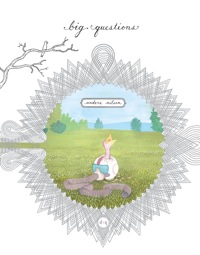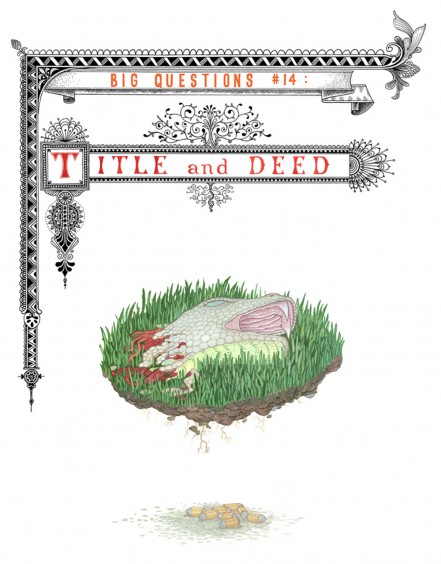 Anders Nilsen: Big Questions (Drawn & Quarterly, 8/16/11)
Anders Nilsen: Big Questions (Drawn & Quarterly, 8/16/11)
Big Questions is a pretty self-explanatory title for the “magnum opus” of Chicago-based writer Anders Nilsen. The story he chooses to tell in a collected 600 pages of comics and writing is indeed about the big questions. But what are those big questions? Nilsen says, “The usual, I suppose: life, death, foundations of human knowledge, the existence of god, stuff like that. Also: what are the best kinds of doughnuts, and whose fault is it when the giant egg explodes?”
All joking aside, Big Questions is nothing at which to sniff. After releasing 15 issues in zine form over the course of a decade, Nilsen and Drawn & Quarterly published a gift-quality collected edition in 2011. That’s not bad for something that started so small; as Nilsen puts it, “The book started with me just playing around in my sketchbooks, doing little gag strips about birds eating seeds and talking about things that were a little bigger than they could really wrap their heads around.” In the end, however, it became a lot more. Big Questions has been an enormous project for Nilsen and is an engrossing read for comic lovers.
It’s hard to talk about what exactly the series is about, but in general, Big Questions follows a pilot who has crashed on a desert island and the talking birds that inhabit said island. The pilot and the birds clash repeatedly, illustrating the best and worst points of enlightened humanity. At 600 pages, the collected Big Questions is quite a lot of reading, but Nilsen’s work is about much more than talking birds; it’s about the human condition itself. As such, there are no easy answers, and everything is open to interpretation.
In most sections of the story, not much happens, and more goes unsaid. For instance, in issue #14 (“Title and Deed”), we encounter an underwear-clad man that seemingly only communicates in grunts. He befriends one of the birds, and the rest of the birds become suspicious that one of their own is fraternizing with a human. They attempt a rescue mission, but not before the pilot returns and finds the underwear-wearing man in his tent. They fight, the birds attempt another rescue, and finally the reader is left wondering why we sympathize the least with the pilot that would be the most civilized and communicative character in any other context.
One of the strongest points in Nilsen’s writing is the contrast between the humans (mute or surly, in this case) and the birds (chatty, organized, communitarian). The birds are planners, schemers, and interconnected; they talk to one another as we would, while the humans – cut off as they are from the rest of their kind – are reduced to muteness, anger, and being misunderstood. They don’t belong on this island, but the birds, along with their extended network of animal pals, fit right in. We can relate to the birds because they have the qualities of humanity that we hold most dear, while the humans have become severed from their sense of communal society.
Nilsen’s stark pen-and-ink style is perfectly suited to the story he wants to tell. Minimalist but never dull, his art pays close attention to body language. It has to, when several pages might go by with no dialogue at all. He also has to show birds in conversation with each other and showing emotion – not an easy feat. Nilsen says, “I try not to have the way I draw call too much attention to itself. I want the drawings to describe, as directly as possible, what’s happening in the story. The quietness and slowness are probably products of my own temperament as much as anything.” The art constructs a lonely world, surrounded by blankness and devoid of color, for his lone protagonist and the birds to live in.
So what are some of the big questions? In this chapter alone, Nilsen asks the reader to think about which of the humans is more “human.” It could be the angry, violent pilot who speaks and acts like us, or the simple man who can form connections with animals (or is it the birds that resemble us most?). There’s the community versus the lone human, sociability versus aggression, speech versus intuition, and selfishness versus compassion. That’s a lot of heavy lifting, all in a few pages of sparsely inked art. Although Big Questions is a complete series, we can surely expect more beautiful and meditative comics from Nilsen in the future.



